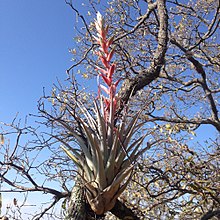
Back Epifiet Afrikaans نبات هوائي Arabic Epifit Azerbaijani Эпіфіты Byelorussian Епифит Bulgarian পরাশ্রয়ী উদ্ভিদ Bengali/Bangla Epifit BS Epífit Catalan Epifyt Czech Эпифитсем CV

An epiphyte is a plant or plant-like organism that grows on the surface of another plant and derives its moisture and nutrients from the air, rain, water (in marine environments) or from debris accumulating around it. The plants on which epiphytes grow are called phorophytes. Epiphytes take part in nutrient cycles and add to both the diversity and biomass of the ecosystem in which they occur, like any other organism. They are an important source of food for many species. Typically, the older parts of a plant will have more epiphytes growing on them. Epiphytes differ from parasites in that they grow on other plants for physical support and do not necessarily affect the host negatively. An organism that grows on another organism that is not a plant may be called an epibiont.[1] Epiphytes are usually found in the temperate zone (e.g., many mosses, liverworts, lichens, and algae) or in the tropics (e.g., many ferns, cacti, orchids, and bromeliads).[2] Epiphyte species make good houseplants due to their minimal water and soil requirements.[3] Epiphytes provide a rich and diverse habitat for other organisms including animals, fungi, bacteria, and myxomycetes.[4]
Epiphyte is one of the subdivisions of the Raunkiær system. The term epiphytic derives from the Greek epi- (meaning 'upon') and phyton (meaning 'plant'). Epiphytic plants are sometimes called "air plants" because they do not root in soil. However, that term is inaccurate, as there are many aquatic species of algae that are epiphytes on other aquatic plants (seaweeds or aquatic angiosperms).
- ^ Hickey, M.; King, C. (2001). The Cambridge Illustrated Glossary of Botanical Terms. Cambridge University Press.
- ^ Webster's Third New International Dictionary of the English Language, Unabridged. (1976). Vol. I, p. 764. Encyclopædia Britannica, Inc. Chicago.
- ^ Dabbs, Amy (19 December 2014). "Epiphytes are easy to grow Houseplants get water from air". Post and Courier. Retrieved 15 December 2016.
- ^ Sydney E. Everhart; Joseph S. Ely; Harold W. Keller (2009). "Evaluation of tree canopy epiphytes and bark characteristics associated with the presence of corticolous myxomycetes" (PDF). Botany. 87 (5): 509–517. doi:10.1139/b09-027. Archived from the original (PDF) on 2013-09-26.
© MMXXIII Rich X Search. We shall prevail. All rights reserved. Rich X Search